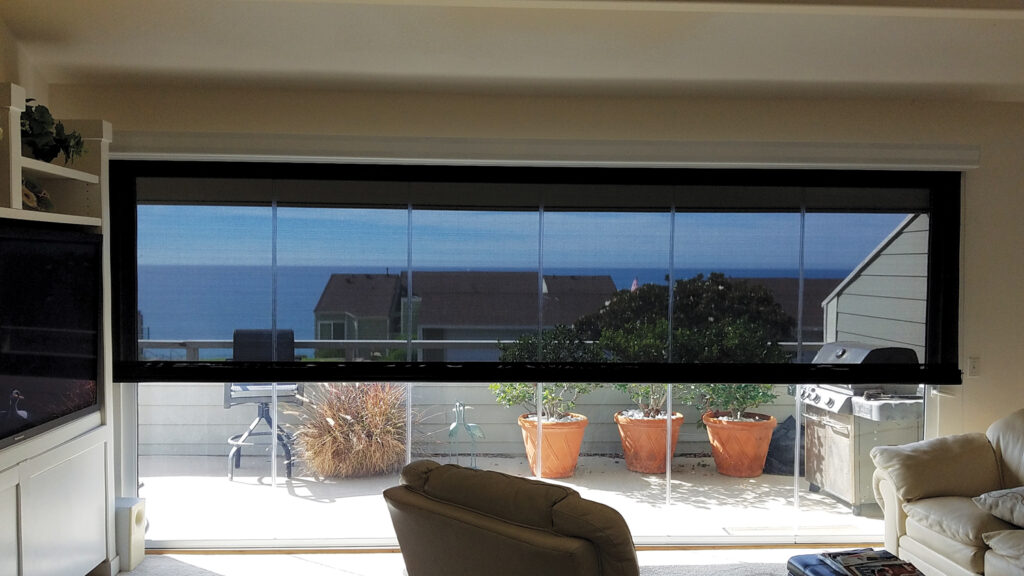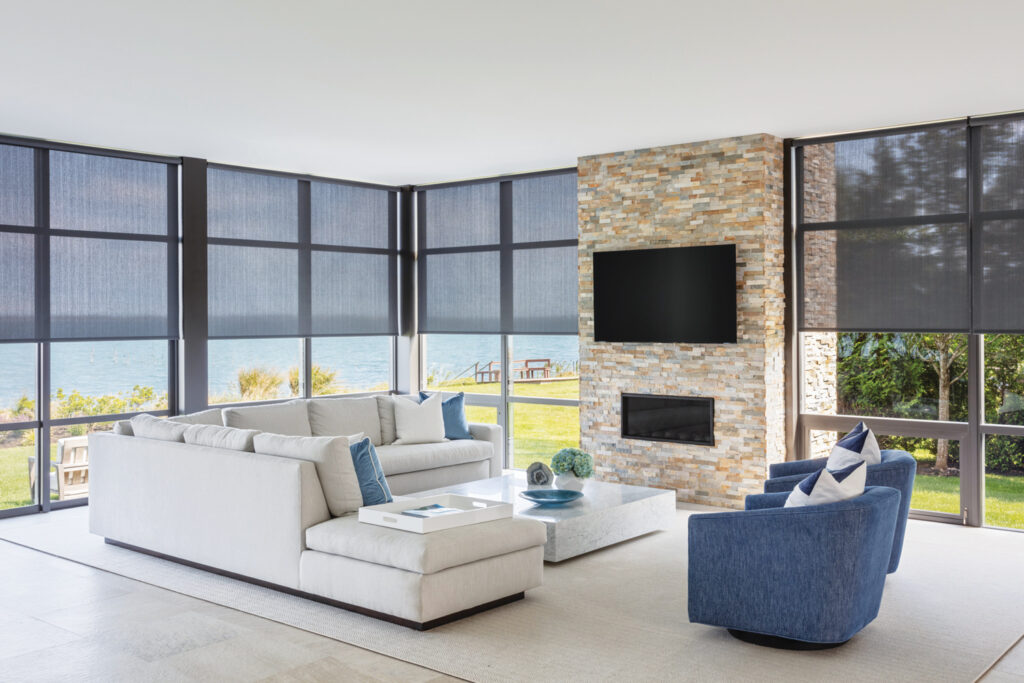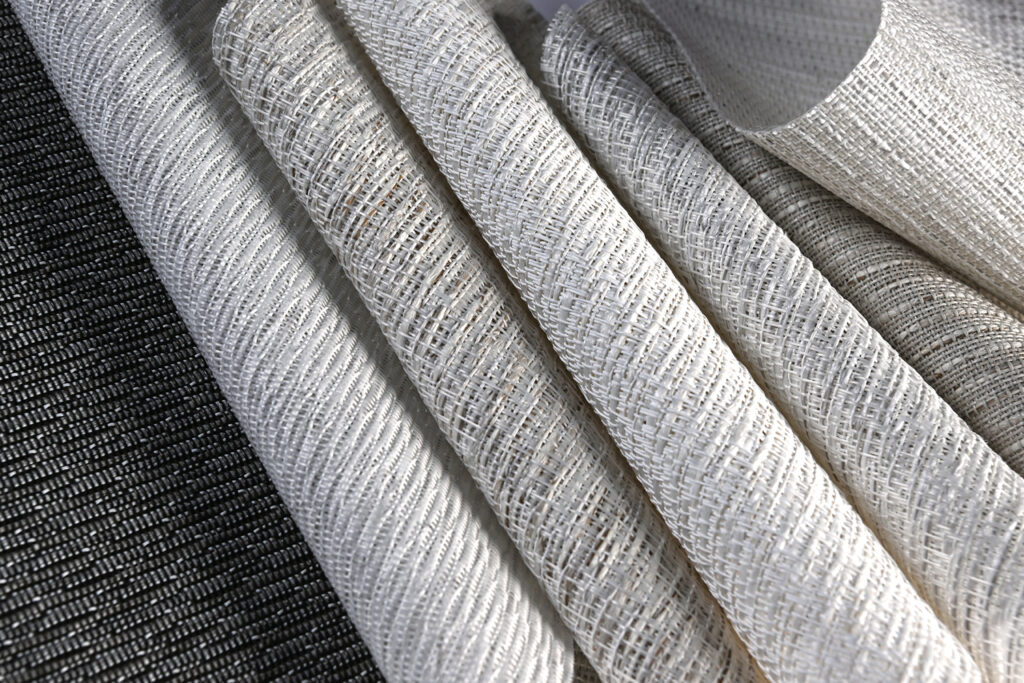New regulations are affecting shade products, but that’s not the only thing going on in this market. Changes in motorization, the way products are used for light control, available color options and demand for sustainabilityare all happening too.
Federal regulation ANSI/WCMA A100.1-2022 went into effect as of June 2024, stating that shades must be cordless or have “inaccessible” or short cords. Although manufacturers prepared for the new child-safety law, end users may not be aware of it, which could affect commercial installations: Building standards often require matching window coverings, says O’D McKewan, product coach at Window Covering World in San Diego, Calif.
Options for raising and lowering shades without pull cords include cordless lift, retractable wands and motorization, McKewan notes, with some limitations of cordless lift including accessibility for people with limited reach, plus size capacity. For instance, he says, current cordless lift mechanisms are unable to handle large windows; one 8-foot window, tall or wide, might require either multiple shades or motorization.
Aside from cord regulation, McKewan calls motorization “the largest impact in interior window covering.” Powered by batteries, rechargeable motors or hardwiring, motorized shades align with consumers’ interests in smart home technology and voice assistants.
The Smart Shade app from Spettmann USA, based in Baldwin Park, Calif., works with motorized shades and voice assistants to open and close window coverings. Its ShadeSync Hub offers the ability to automate shade positions according to temperature, while a SunTracker offers control according to the sun’s positioning. Both applications, says David Cowie, president of Spettmann’s Melbourne, Australia-based app development partner, t2fi, provide energy-efficiency benefits. “The window is the worst instigator of letting heat in and out of the home,” he says, which greatly affects a building’s heating and cooling energy requirements and running costs.
Mermet USA tackles energy-efficiency concerns through the roller shade fabrics it manufactures in Cowpens, S.C. Its KOOLBLACK® line of vinyl-coated fiberglass fabrics reflect infrared heat. Product manager Nathan Wintermute offers the analogy, “If you’re wearing a white T-shirt, you’re going to be cooler than if you’re wearing a black T-shirt. Same is true with window shades: white-colored fabrics reflect more heat.” The technology infused into KOOLBLACK’s vinyl, however, allows even darker-colored fabrics to reflect heat while maintaining an advantage in glare control.
Phifer Inc.’s SheerWeave® roller shade fabrics are designed to reduce solar heat gain, thereby lowering utility bills and reducing the need for electricity, says Andrew Caldwell, national market manager for the Tuscaloosa, Ala., company.

Light control: combining products
Indoor shades are best known for managing light, and today’s customers want to exert control in this area. “We are seeing tons of requests for blackout privacy products,” Wintermute says.
McKewan notes that with slatted blind products, “You have the ability to control your view, privacy and the amount of light that comes through, but when you use roller shades, it becomes what we call the all-or-none principle, where, when the shade is down, you have none of your view if you’re using a room-darkening or privacy fabric. When the shade comes up, you have none of your privacy.” Some clients, he says, want to solve this issue with dual shades: a sheerer one for view and a room-darkening one for privacy, mounted in the same window. Such installations can have practical challenges. “You have to have two cordless lifts for two shades,” McKewan says. “Now I’m doubling the space I need [to install them].”
Consumers who install dual shades want them to match. Over the past five to 10 years, Wintermute says, Mermet has seen an increased demand for products that match a blackout to a light-filtering fabric. Its partner collections use the same base cloth for blackout and light-filtering fabrics so that they can be installed together either in a dual roller system or throughout a structure for visual continuity. “As we’re developing new products to come to market with, that’s a key aspect of our development processes. If we’re launching a blackout product or if we’re launching a light-filtering product, we want to make sure we have the partner collection as well,” Wintermute says.
Phifer’s customers, Caldwell says, often combine shade products from the same line but with different openness factors. This allows for color matching with different levels of light penetration. Recently, customers have been asking for tighter-weave fabrics. “For years and years, 5% openness was our most popular. [Now], 3% is actually our most popular,” he says. Phifer has also added 1% openness weaves to its fabric lines.
Those different openness factors combine with different weaves—Phifer’s Alabama plant makes basketweave, twill weave and jacquard fabrics—and different colors within a product line. “You can use a 1% all by itself, but a lot of times, it’s being used in combination,” Caldwell explains. “Maybe on a northern exposure or something that doesn’t have direct sun, they’ll use a more open fabric, and then somewhere they want a tighter woven fabric to help with additional heat gain or glare control, they’ll use a 1%.”

A shift toward earth tones
While weaves may be getting tighter, new windows are getting bigger. Architectural trends, McKewan says, are seeing living rooms built with 30-foot-wide walls of glass or master bedrooms with 12-to-18-foot-wide sliding glass doors. Finding a single piece of fabric large enough to cover such items, he says, is a challenge.
“Windows are always getting wider,” Wintermute acknowledges. While Mermet still offers fabrics in legacy widths of 2 or 2.5 meters (6.6 or 8.2 feet) wide, its most popular width is 3.1 meters (10.2 feet). “If we’re launching new fabric, it has to be, at a minimum, that wide, so it allows for a full 10-foot-wide shade,” he says.
Mermet recently launched new blackout fabrics, the Elba Twilight™ and Sofia Twilight™ indoor shade lines, in the 3-meter (9.8-foot) width. “The Sofia is more of a subtler texture, and the Elba Twilight is a little bit of a bolder choice. Both have a horizontal slub to them, and they really lean into the beige tones,” Wintermute says.
In all fabric collections, he says, “We’ve got to have at least one bright white. That is nonnegotiable.” In addition to whites and off-whites, he says, color trends are leaning toward beiges and taupe, on the lighter side of the brown color family. “Customers just want options,” he says. “They want to have lots of different patterns to pick from.”
Some color influence, Wintermute says, is coming from relaxed homeowners’ association regulations, which may allow darker colors and stronger decorative patterns. Darker trim colors, with homeowners wanting shades to match, is also a factor, he says.
Caldwell agrees that color preferences have shifted in decorative and light-filtering fabrics. “For a while, the grays were really hot, very popular,” he says. While those colors are still around, he says the preferred neutral has shifted to warmer colors of brown. Caldwell adds that while market trends may influence decorative lines in terms of colors and textures, “a basic solar screen is pretty set. We’ve been making some of these styles for 20 and 30 years.”

A bright future for indoor shades
Innovation in shades, Caldwell says, is likely to come in the area of environmental sustainability. “I think the future is still going to be people looking for those eco-friendly products, via that more recyclability aspect in terms of end product and also in terms of raw materials.”
The impact of chemical regulatory changes, Wintermute says, is another thing to watch for in the future of the indoor shade industry. He says Mermet keeps an eye on and responds to changes in approved chemical makeups for its fabrics and coatings. In addition to phasing out polyfluoroalkyl substances (PFAS) for water repellency, he mentions a 2021 ban on the decabromodiphenyl ether (decaBDE) halogenated flame retardant, with more flame retardant bans following.
The flame-retardant additive antimony trioxide has been banned in Massachusetts, but customers, Wintermute says, “don’t want to have a particular product that can only be sold in Massachusetts. They want to be able to sell a product anywhere in the United States.” To that end, Mermet spent about a year developing a version of its standard screen products that doesn’t contain antimony trioxide, using a proprietary solution.
“It’s a very difficult balancing act between getting the right properties and maintaining the cost, because you can pump a product full of flame-retardant chemicals, but it greatly increases the cost. If we’re trying to achieve a one-to-one match, the cost can’t go up more than 5%, and you don’t want to go up at all, if possible,” he says.
Current changes within the industry, McKewan says, are largely focused on hardware updates to accommodate the new cord regulations. He predicts more motorization, especially as motors become smaller and stronger. Just like current purchasers of televisions expect a remote to come with the set, McKewan says, “That’s how window coverings are going to be. You’re just not going to have any options. They will be motorized.”

He also suggests that homeowners and architects will have to make modifications such as increased sill depth to accommodate the function of new window-covering technologies. “It’s just like kitchens have to be bigger to hold all of your refrigerators and bigger cooktops; it’s going to be the same type of thing,” he says.
In the European indoor shade market, McKewan says he has seen advances like solarized window coverings, meaning they go beyond providing UV protection and function as solar panels and turn light into electricity. Europeans, he says, “are working directly on energy efficiency for those products.”
Spettmann, according to Wilson Weng, vice president of sales and marketing, launched a solar panel to provide energy to motorized shades in the U.S. market in 2024. It also sells a mini, matchbox-sized version of its control hub that could be retrofitted to existing motors powered by rechargeable batteries in order to offer those shade owners the ability to program adjustments. In 2025, the company intends to make its ShadeScreen app touchscreen hub available to consumers through mass merchants.
As windows get bigger, color and decorative choices get a bit bolder, and manufacturers respond to chemical bans, shade products get better in the options they provide to consumers for light control, sustainability and more.
Joanna Werch Takes is a writer and editor based in Minnesota.
Both Mermet and Phifer cite efforts toward sustainability in the manufacture of their fabrics, several of which have earned certifications that make them eligible toward LEED building credits. Mermet’s GreenScreen® line is made with polyester created from repurposed, reused water bottles. “They get chopped up and reprocessed into polyester pellets that can then be produced into yarn. And then we produce fabrics from the yarn to meet our specifications, including with color and openness,” product manager Nathan Wintermute says.
Phifer’s SheerWeave® 8000 line is a 100% recyclable polyester fabric. Its Infinity 2 line is made from 100% postindustrial byproduct, “and then it is 100% recyclable itself,” says national market manager Andrew Caldwell. “Not only do we capture the scrap here in our production, but we have a program for our customers to return the scrap to us from their production of shades.” At the end of a product’s life cycle, end users such as homeowners or building managers could also return the product to Phifer.







Leave A Comment